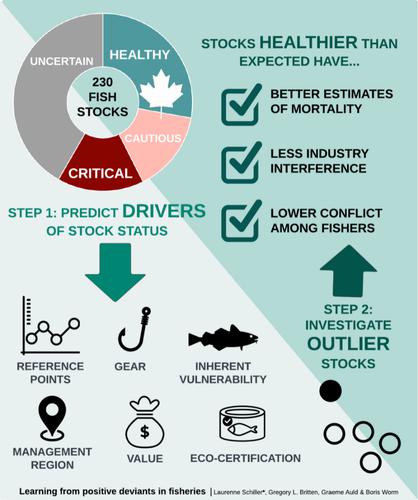当前位置:
X-MOL 学术
›
Fish Fish.
›
论文详情
Our official English website, www.x-mol.net, welcomes your
feedback! (Note: you will need to create a separate account there.)
Learning from positive deviants in fisheries
Fish and Fisheries ( IF 5.6 ) Pub Date : 2024-02-05 , DOI: 10.1111/faf.12815 Laurenne Schiller 1 , Gregory L. Britten 2, 3 , Graeme Auld 1 , Boris Worm 4
Fish and Fisheries ( IF 5.6 ) Pub Date : 2024-02-05 , DOI: 10.1111/faf.12815 Laurenne Schiller 1 , Gregory L. Britten 2, 3 , Graeme Auld 1 , Boris Worm 4
Affiliation

|
Despite progress in the management of assessed fish populations, many countries lag behind international commitments to restore overexploited stocks to healthy abundances. Here we use a mixed-methods positive deviance approach, also known as ‘bright spot’ analysis, to understand what drives the successful governance of exploited species by learning from positive outliers, or ‘deviants’. We use Canada as a case study, identifying factors driving the abundance of 230 commercially exploited fish and invertebrate populations, of which only 28% were classified at healthy abundance in 2022. We first applied a generalized linear model to test how diverse socio-ecological fishery attributes relate to stock health. We found healthier stocks are positively and significantly correlated with certain management regions, more selective gears, eco-certification, and high fishery value. Counterintuitively, healthier stocks were also associated with high inherent fishing vulnerability and the absence of reference points. We then used fishery expert surveys and interviews to investigate the social and institutional characteristics of stocks healthier than expected, given their circumstances. We found that fisheries targeting these positive outliers have lower conflict among users, balanced stakeholder involvement in data collection and decision-making, and improved accounting of mortality sources. Lessons from these positive deviants can be applied to improve underperforming management systems that are struggling to reverse overexploitation in Canada and elsewhere. More generally, we suggest that a positive deviance approach, already used in public health, could be a promising tool to learn about successful fisheries management interventions, and the diverse actors responsible for ensuring these interventions are successful.
中文翻译:

向渔业中的积极偏差学习
尽管在评估鱼类种群管理方面取得了进展,但许多国家在将过度捕捞的种群恢复到健康丰度方面仍落后于国际承诺。在这里,我们使用混合方法正偏差方法(也称为“亮点”分析),通过向正异常值或“偏差”学习来了解推动被剥削物种成功治理的因素。我们以加拿大为案例研究,确定了驱动 230 种商业开发鱼类和无脊椎动物种群丰度的因素,其中只有 28% 的种群在 2022 年被归类为健康丰度。我们首先应用广义线性模型来测试社会生态渔业的多样性属性与种群健康状况相关。我们发现,更健康的种群与某些管理区域、更具选择性的渔具、生态认证和高渔业价值呈正相关且显着相关。与直觉相反,更健康的种群也与较高的固有捕捞脆弱性和缺乏参考点有关。然后,我们利用渔业专家调查和访谈来调查比预期更健康的种群的社会和制度特征,考虑到它们的情况。我们发现,针对这些积极异常值的渔业可以减少用户之间的冲突,平衡利益相关者参与数据收集和决策的情况,并改进对死亡率来源的核算。从这些积极的偏差中吸取的教训可以用来改善表现不佳的管理体系,这些体系正在努力扭转加拿大和其他地方的过度开发现象。更一般地说,我们建议已经在公共卫生领域使用的积极偏差方法可能是了解成功的渔业管理干预措施以及负责确保这些干预措施成功的不同参与者的有前途的工具。
更新日期:2024-02-05
中文翻译:

向渔业中的积极偏差学习
尽管在评估鱼类种群管理方面取得了进展,但许多国家在将过度捕捞的种群恢复到健康丰度方面仍落后于国际承诺。在这里,我们使用混合方法正偏差方法(也称为“亮点”分析),通过向正异常值或“偏差”学习来了解推动被剥削物种成功治理的因素。我们以加拿大为案例研究,确定了驱动 230 种商业开发鱼类和无脊椎动物种群丰度的因素,其中只有 28% 的种群在 2022 年被归类为健康丰度。我们首先应用广义线性模型来测试社会生态渔业的多样性属性与种群健康状况相关。我们发现,更健康的种群与某些管理区域、更具选择性的渔具、生态认证和高渔业价值呈正相关且显着相关。与直觉相反,更健康的种群也与较高的固有捕捞脆弱性和缺乏参考点有关。然后,我们利用渔业专家调查和访谈来调查比预期更健康的种群的社会和制度特征,考虑到它们的情况。我们发现,针对这些积极异常值的渔业可以减少用户之间的冲突,平衡利益相关者参与数据收集和决策的情况,并改进对死亡率来源的核算。从这些积极的偏差中吸取的教训可以用来改善表现不佳的管理体系,这些体系正在努力扭转加拿大和其他地方的过度开发现象。更一般地说,我们建议已经在公共卫生领域使用的积极偏差方法可能是了解成功的渔业管理干预措施以及负责确保这些干预措施成功的不同参与者的有前途的工具。


















































 京公网安备 11010802027423号
京公网安备 11010802027423号